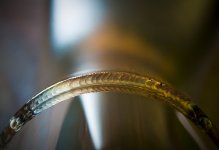ive learned a few things and alot was from some old welders. one thing i learned realy quick was to never argue with one. listen and learn.
That's the main thing
I can't argue with! :hehe:
Both Dustin & Tony are correct, but it's like a couple of blind guys arguing over what an elephant looks like - one's holding the trunk & the other's grabbing the ear.
Even though they know their trades well and are no doubt at the top of their professions, it's difficult for one person to know everything (or often even most things) about a fabrication process.
For example, in some applications it's beneficial to TIG stainless hot (= fast) to lower the total heat flux input via the weld, since stainless is a less efficient conductor of thermal energy than carbon steel - yet deforms significantly more than steel from elevated temperature.
I have often demonstrated to apprentices & journeymen how a fast 308L fillet @ 150 amps produces a cleaner, smoother, brighter weld than slow, heat-soaking low-amperage passes.
A professional TIG weld needs only a fine SS wire brushing to erase the heat zoning and clean the weld's carbon precipitation zone - but it should be brushed before the metal cools below a few hundred degrees (much easier & better looking that way). Purging & nitric passivating can be a PITA, and significantly increases manufacturing time unless we're talking batch processing, intricate weldments or process piping.
Nickel & chromium can "burn out" of stainless steel at >bright orange color temperatures - something we always had to monitor while hot forging 300 series and of course for refractory combustion chamber applications.
Obviously, excessive heat input from poor welding technique can also downgrade 316 to 304, to a magnetic 400-ish or even into straight carbon steel.
I've only been getting paid to TIG since 1981, so even though I've TIG'd everything from aluminum beer cans & inconel electrodes to magnesium radar antennae for the Navy, I figure there's still plenty to learn! :Cheer:
p.s. Nice job on the header - that should be your thesis for your TIG Master.

